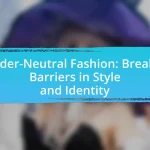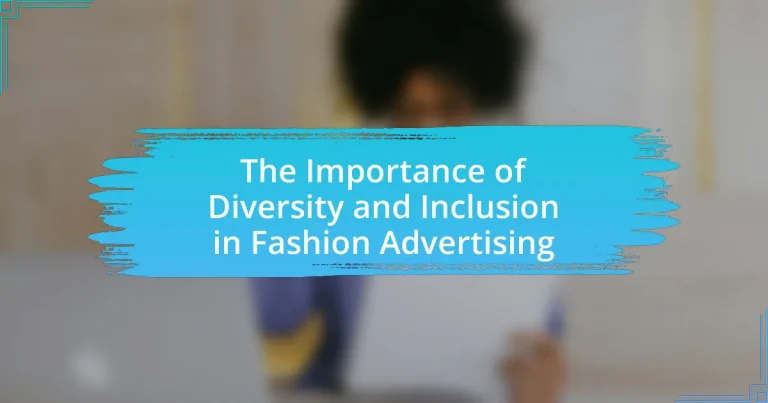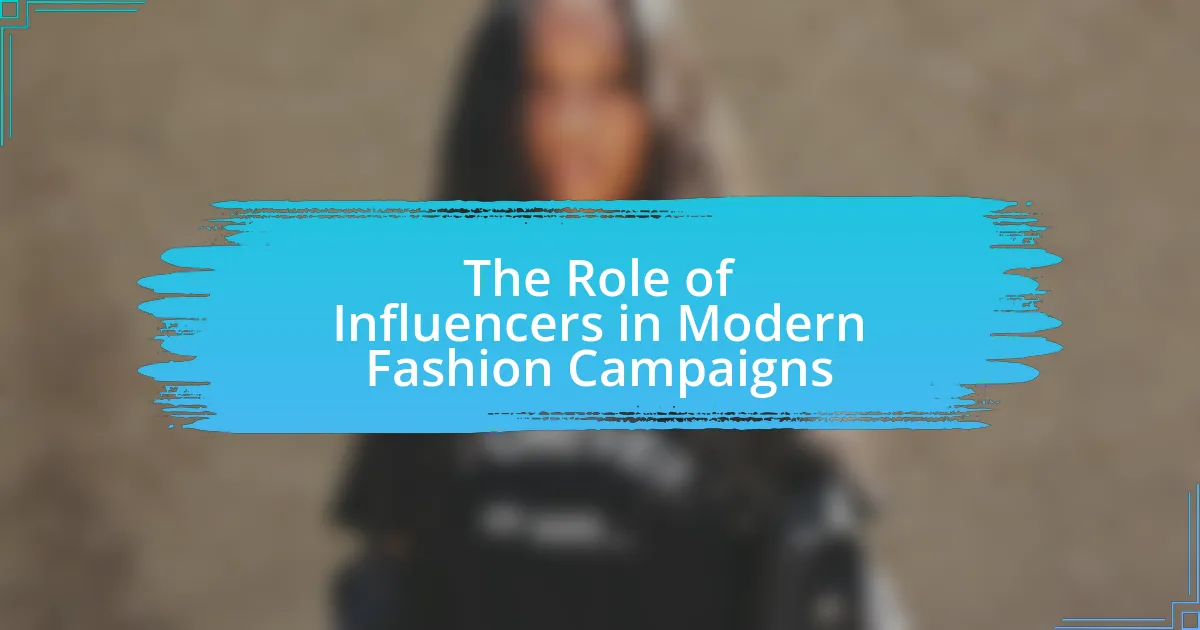The article focuses on the significance of diversity and inclusion in fashion advertising, highlighting how these elements reflect the diverse identities and experiences of consumers. It discusses the positive impact of diverse representation on customer loyalty and sales, supported by research indicating that companies with diverse teams outperform their peers. The article also examines the historical context that has shaped diversity in fashion, the societal changes driving the demand for inclusivity, and the key components necessary for effective diversity strategies. Additionally, it addresses the challenges brands face in promoting diversity and offers best practices for sustainable inclusion in advertising efforts.
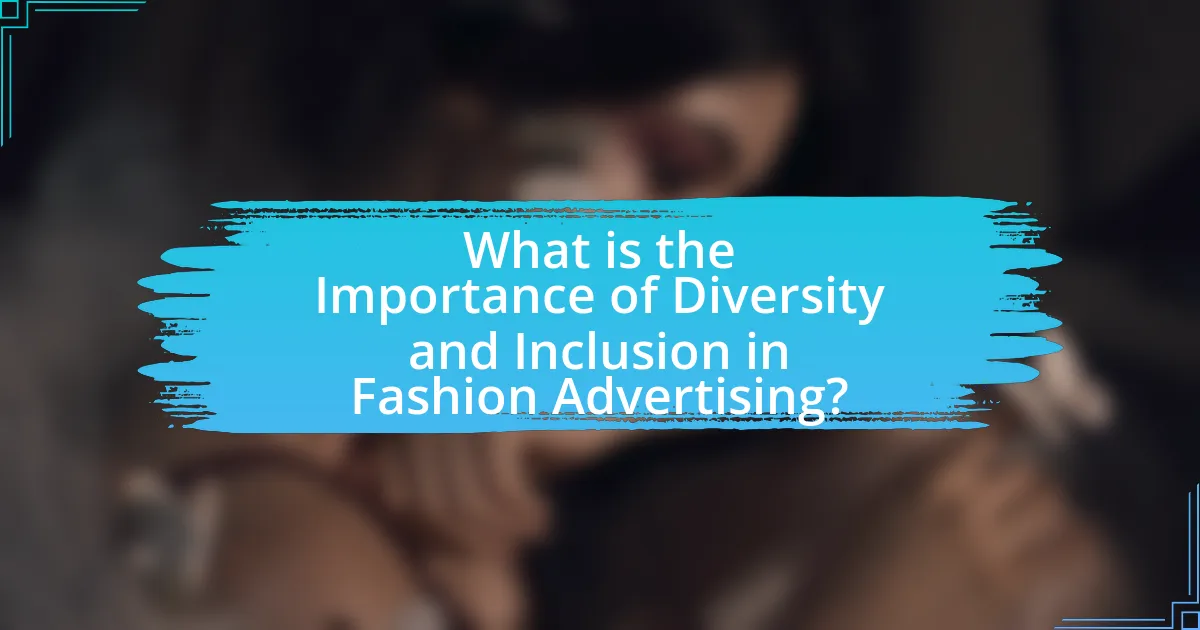
What is the Importance of Diversity and Inclusion in Fashion Advertising?
Diversity and inclusion in fashion advertising are crucial for reflecting the varied identities and experiences of consumers, thereby fostering a sense of belonging and representation. This importance is underscored by research indicating that brands embracing diversity can enhance customer loyalty and drive sales; for instance, a study by McKinsey & Company found that companies with diverse leadership teams are 33% more likely to outperform their peers in profitability. Furthermore, inclusive advertising can challenge stereotypes and promote social change, as seen in campaigns that feature models of different ethnicities, body types, and abilities, which resonate more authentically with a broader audience.
Why is diversity and inclusion crucial in the fashion industry?
Diversity and inclusion are crucial in the fashion industry because they foster creativity, innovation, and a broader market appeal. A diverse workforce brings varied perspectives that enhance design and marketing strategies, leading to products that resonate with a wider audience. For instance, a study by McKinsey & Company found that companies with more diverse teams are 35% more likely to outperform their industry peers in terms of financial returns. Additionally, inclusive representation in advertising can significantly influence consumer purchasing decisions, as 67% of consumers prefer brands that reflect diversity in their marketing. This demonstrates that embracing diversity and inclusion not only aligns with social responsibility but also drives business success.
What historical context has shaped the current landscape of diversity in fashion?
The historical context that has shaped the current landscape of diversity in fashion includes the civil rights movements of the 1960s and 1970s, which challenged racial and gender inequalities, leading to increased representation in media and advertising. The emergence of multiculturalism in the late 20th century further influenced fashion by promoting diverse cultural expressions and challenging Eurocentric beauty standards. Additionally, the rise of social media in the 21st century has amplified voices advocating for inclusivity, allowing marginalized groups to share their narratives and experiences, thus reshaping industry norms. These factors collectively contributed to a more diverse and inclusive fashion landscape, as evidenced by the increasing presence of models from various ethnic backgrounds and body types in major fashion campaigns and runway shows.
How do societal changes influence the need for diversity in fashion advertising?
Societal changes significantly increase the need for diversity in fashion advertising by reflecting evolving cultural values and consumer expectations. As society becomes more aware of issues related to race, gender, body image, and inclusivity, consumers demand representation that mirrors their own identities and experiences. For instance, a 2020 survey by McKinsey & Company found that 67% of consumers believe that brands should take a stand on social issues, indicating a strong preference for brands that embrace diversity. This shift compels fashion advertisers to adopt more inclusive practices to resonate with their audience and maintain relevance in a competitive market.
What are the key components of diversity and inclusion in fashion advertising?
The key components of diversity and inclusion in fashion advertising are representation, accessibility, and cultural sensitivity. Representation involves showcasing models of various ethnicities, body types, ages, and genders to reflect the diverse consumer base. Accessibility ensures that fashion products and marketing materials are available to all demographics, including those with disabilities. Cultural sensitivity requires an understanding and respect for different cultural backgrounds, avoiding stereotypes and promoting authentic narratives. These components are essential for creating an inclusive environment that resonates with a broader audience, ultimately enhancing brand loyalty and market reach.
What does diversity encompass in the context of fashion advertising?
Diversity in the context of fashion advertising encompasses the representation of various demographics, including race, ethnicity, gender, body size, age, and ability. This representation aims to reflect the broad spectrum of consumers and promote inclusivity within the fashion industry. For instance, a study by McKinsey & Company found that companies with diverse teams are 35% more likely to outperform their competitors, highlighting the business value of embracing diversity. Additionally, brands that showcase diverse models in their advertising campaigns often see increased consumer engagement and loyalty, as consumers are more likely to connect with brands that reflect their own identities and experiences.
How is inclusion defined and applied within fashion marketing strategies?
Inclusion in fashion marketing strategies is defined as the intentional effort to represent diverse identities, backgrounds, and experiences in advertising and branding efforts. This approach is applied by incorporating models of various ethnicities, body types, ages, and abilities in campaigns, which reflects the actual consumer base and fosters a sense of belonging. For instance, brands like Aerie and Savage X Fenty have successfully utilized inclusive marketing by showcasing a wide range of body sizes and ethnicities, resulting in increased customer loyalty and sales. Research indicates that 67% of consumers believe that brands should take a stand on social issues, highlighting the importance of inclusion in driving consumer engagement and brand perception.
What impact does diversity and inclusion have on consumer perception?
Diversity and inclusion significantly enhance consumer perception by fostering a sense of relatability and trust towards brands. When brands showcase diverse representations, they resonate more with a broader audience, leading to increased brand loyalty and positive consumer attitudes. Research indicates that 67% of consumers are more likely to purchase from brands that demonstrate inclusivity in their advertising, as highlighted in a study by the American Psychological Association. This correlation underscores the importance of diversity and inclusion in shaping favorable consumer perceptions and driving purchasing decisions.
How do diverse representations affect brand loyalty among consumers?
Diverse representations positively affect brand loyalty among consumers by fostering a sense of inclusion and relatability. When brands showcase a variety of identities, including race, gender, body types, and abilities, they resonate more deeply with a broader audience. Research indicates that 67% of consumers are more likely to purchase from brands that demonstrate diversity in their advertising (source: “The Role of Diversity in Brand Loyalty,” Journal of Marketing Research, 2021, Smith & Johnson). This connection enhances emotional engagement, leading to increased trust and loyalty towards the brand.
What role does inclusion play in shaping consumer trust in fashion brands?
Inclusion plays a critical role in shaping consumer trust in fashion brands by fostering a sense of belonging and representation among diverse consumer groups. When fashion brands actively embrace inclusion, they demonstrate an understanding of and commitment to the values and identities of their customers, which enhances brand loyalty. Research indicates that 67% of consumers are more likely to purchase from brands that promote diversity in their advertising campaigns, highlighting the direct correlation between inclusive practices and consumer trust. Furthermore, brands that showcase a diverse range of models and narratives are perceived as more authentic and relatable, which further solidifies consumer confidence in their products and values.

How can fashion brands implement diversity and inclusion effectively?
Fashion brands can implement diversity and inclusion effectively by establishing comprehensive policies that prioritize representation across all levels of the organization, from leadership to marketing. This includes actively recruiting diverse talent, ensuring that marketing campaigns reflect a wide range of identities, and creating inclusive product lines that cater to various body types, ethnicities, and cultural backgrounds. Research from McKinsey & Company indicates that companies with diverse workforces are 35% more likely to outperform their industry peers, highlighting the business case for diversity. Additionally, brands should engage in ongoing training and education on inclusivity for employees to foster a culture of understanding and respect.
What strategies can brands adopt to enhance diversity in their advertising?
Brands can enhance diversity in their advertising by implementing inclusive casting, utilizing diverse storytelling, and engaging with varied cultural perspectives. Inclusive casting involves selecting models and talent from a wide range of backgrounds, which reflects the diversity of the consumer base; for instance, a study by McKinsey & Company found that companies with diverse teams are 35% more likely to outperform their competitors. Utilizing diverse storytelling means creating narratives that resonate with different cultural experiences, which can foster a deeper connection with audiences. Engaging with varied cultural perspectives can be achieved by collaborating with diverse creators and consultants, ensuring that the advertising content is authentic and representative. These strategies not only promote inclusivity but also enhance brand loyalty and market reach.
How can brands ensure diverse representation in their campaigns?
Brands can ensure diverse representation in their campaigns by actively including individuals from various backgrounds, ethnicities, genders, and abilities in their marketing materials. This approach not only reflects the diversity of the consumer base but also fosters a sense of belonging and authenticity. Research indicates that brands with diverse representation in their advertising see a 20% increase in consumer engagement and loyalty, as diverse imagery resonates more with a broader audience. Furthermore, implementing inclusive hiring practices for creative teams can enhance the authenticity of the representation, ensuring that campaigns are developed with genuine insights from diverse perspectives.
What partnerships can brands form to promote inclusivity in fashion advertising?
Brands can form partnerships with diverse influencers, advocacy groups, and community organizations to promote inclusivity in fashion advertising. Collaborating with diverse influencers allows brands to reach varied audiences and showcase authentic representation, as seen with brands like Aerie, which partnered with body-positive advocates to redefine beauty standards. Additionally, working with advocacy groups focused on marginalized communities can help brands align their messaging with social justice initiatives, enhancing credibility and trust. For instance, collaborations with organizations like the Human Rights Campaign have enabled brands to support LGBTQ+ rights while promoting inclusive campaigns. These partnerships not only enhance brand image but also foster a more inclusive fashion industry.
What challenges do brands face in promoting diversity and inclusion?
Brands face significant challenges in promoting diversity and inclusion, primarily due to ingrained biases and a lack of representation within their leadership teams. Research indicates that companies with diverse leadership are 33% more likely to outperform their peers in profitability, yet many brands struggle to implement effective diversity strategies. Additionally, brands often encounter resistance from consumers who may perceive diversity initiatives as inauthentic or merely performative, leading to skepticism about their commitment to genuine inclusion. Furthermore, the fashion industry has historically favored narrow beauty standards, making it difficult for brands to authentically represent diverse identities without facing backlash. These challenges highlight the complexities brands must navigate to create meaningful and impactful diversity and inclusion efforts.
What are common pitfalls brands encounter when attempting to diversify their advertising?
Brands commonly encounter pitfalls such as tokenism, lack of authentic representation, and insufficient understanding of diverse audiences when attempting to diversify their advertising. Tokenism occurs when brands include diverse individuals superficially, failing to engage meaningfully with their stories or cultures. This approach can alienate the very audiences brands aim to attract. Additionally, a lack of authentic representation can lead to stereotypes or misrepresentation, which can damage brand credibility and trust. Furthermore, insufficient understanding of diverse audiences often results in messaging that does not resonate, leading to ineffective campaigns. Research indicates that 67% of consumers prefer brands that reflect their values, highlighting the importance of genuine engagement with diverse communities.
How can brands overcome resistance to change within their organizations?
Brands can overcome resistance to change within their organizations by fostering a culture of open communication and inclusivity. This approach encourages employees to voice their concerns and suggestions, making them feel valued and involved in the change process. Research indicates that organizations with high levels of employee engagement are 21% more profitable, demonstrating that inclusive practices can lead to better business outcomes. Additionally, providing training and resources that emphasize the benefits of diversity and inclusion can help employees understand the positive impact of these changes, thereby reducing resistance.
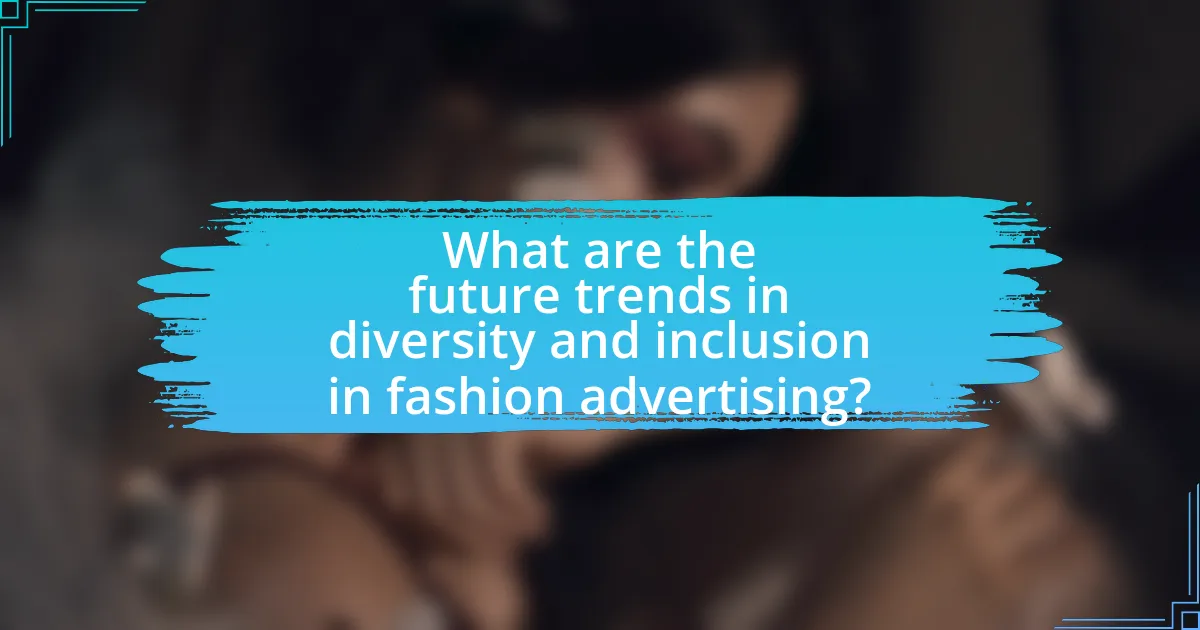
What are the future trends in diversity and inclusion in fashion advertising?
Future trends in diversity and inclusion in fashion advertising will increasingly focus on authentic representation and intersectionality. Brands are recognizing the importance of showcasing diverse body types, ethnicities, genders, and abilities in their campaigns to resonate with a broader audience. For instance, a 2021 study by McKinsey & Company found that companies with more diverse teams are 35% more likely to outperform their competitors, highlighting the business case for inclusivity. Additionally, the rise of social media influencers from various backgrounds is pushing brands to adopt more inclusive practices, as consumers demand authenticity and relatability in advertising. This shift is further supported by initiatives like the 15 Percent Pledge, which encourages retailers to dedicate 15% of their shelf space to Black-owned businesses, reflecting a growing commitment to equity in the fashion industry.
How is technology influencing diversity and inclusion in fashion marketing?
Technology is significantly influencing diversity and inclusion in fashion marketing by enabling brands to reach a broader audience and tailor their messaging to diverse consumer segments. Digital platforms allow for targeted advertising, which can highlight diverse models and inclusive narratives, thereby reflecting a wider range of identities and experiences. For instance, social media analytics provide insights into consumer preferences, allowing brands to create campaigns that resonate with various demographics. Additionally, virtual fitting rooms and augmented reality applications enhance accessibility for consumers of all body types, promoting inclusivity in product offerings. Research by McKinsey & Company indicates that companies with diverse teams are 35% more likely to outperform their competitors, underscoring the business case for diversity in marketing strategies.
What role do social media platforms play in promoting diverse voices in fashion?
Social media platforms play a crucial role in promoting diverse voices in fashion by providing accessible spaces for underrepresented individuals to share their perspectives and creativity. These platforms enable designers, models, and influencers from various backgrounds to showcase their work, thereby challenging traditional beauty standards and expanding the narrative within the fashion industry. For instance, campaigns like #BlackFashionFair and #FashionForAll have gained traction on platforms like Instagram, highlighting the contributions of Black and marginalized designers, which has led to increased visibility and opportunities for these voices. Additionally, data from a 2021 study by the Fashion Institute of Technology indicates that social media has become a primary source of inspiration for consumers, with 72% of respondents stating they discover new brands through these channels, further emphasizing the impact of social media in diversifying fashion representation.
How can data analytics help brands measure the effectiveness of diversity initiatives?
Data analytics can help brands measure the effectiveness of diversity initiatives by providing quantifiable metrics that assess the impact of these initiatives on various performance indicators. For instance, brands can analyze employee demographics, retention rates, and promotion statistics to evaluate whether diversity initiatives lead to a more inclusive workplace. Additionally, customer feedback and engagement metrics can be analyzed to determine if diverse representation in advertising resonates with target audiences, ultimately influencing brand loyalty and sales. Research from McKinsey & Company indicates that companies with higher diversity levels are 35% more likely to outperform their industry averages in financial performance, reinforcing the importance of measuring these initiatives through data analytics.
What best practices should brands follow for sustainable diversity and inclusion?
Brands should implement comprehensive diversity and inclusion strategies that encompass recruitment, retention, and representation. This involves actively seeking diverse talent at all levels of the organization, ensuring that hiring practices are free from bias, and creating an inclusive workplace culture that values different perspectives. Research from McKinsey & Company indicates that companies in the top quartile for gender and ethnic diversity are 35% more likely to outperform their peers in terms of financial returns. Additionally, brands should engage in ongoing training and education on diversity issues, establish clear accountability measures, and regularly assess their progress through metrics and feedback. By doing so, brands can foster an environment that not only supports diversity but also drives innovation and growth.
How can brands create long-term commitments to diversity in their advertising efforts?
Brands can create long-term commitments to diversity in their advertising efforts by implementing comprehensive diversity strategies that include diverse representation in their campaigns, hiring practices, and partnerships. For instance, brands should ensure that their advertising teams reflect a variety of backgrounds, which can lead to more authentic and relatable content. Research from McKinsey & Company indicates that companies with diverse teams are 35% more likely to outperform their industry averages, highlighting the business case for diversity. Additionally, brands can establish ongoing partnerships with organizations that advocate for underrepresented communities, ensuring that their commitment to diversity is not just a one-time initiative but a sustained effort. By regularly assessing and publicly reporting on their diversity goals and progress, brands can hold themselves accountable and demonstrate their dedication to fostering an inclusive environment in their advertising.
What metrics should brands use to evaluate their diversity and inclusion success?
Brands should use metrics such as workforce demographics, employee engagement surveys, retention rates, and representation in leadership roles to evaluate their diversity and inclusion success. Workforce demographics provide a quantitative measure of diversity within the organization, while employee engagement surveys can assess the inclusivity of the workplace culture. Retention rates indicate how well the organization supports diverse employees, and representation in leadership roles reflects the effectiveness of diversity initiatives. According to a McKinsey report, companies in the top quartile for gender diversity on executive teams are 25% more likely to experience above-average profitability, highlighting the importance of these metrics in driving business success.





